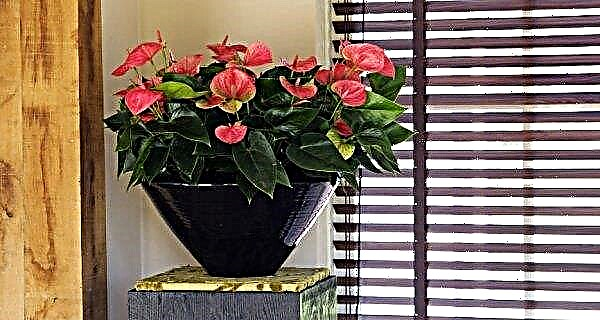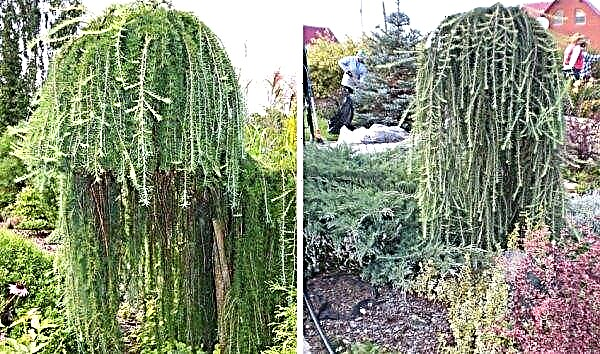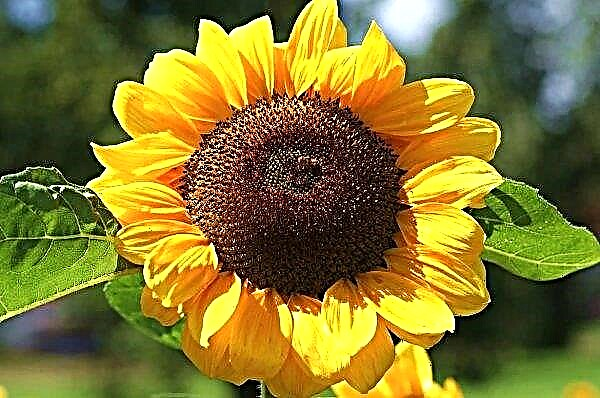Greenhouse plants need additional lighting during a short day. One of the types of lamps used is a sodium lamp. On the advantages and disadvantages, as well as on the principles of operation of the device, see below in detail in the article.
What are sodium lamps
A sodium lamp (hereinafter referred to as NL) is a monochrome light source, originally used for street lighting, and is especially effective in the presence of fog. The color spectrum is all shades of yellow, the type of light is flickering. The power source for the luminaire is a gas discharge in the filler of sodium vapor, operating from the mains.
Did you know? In the Guinness Book there is a record of a long-lived lamp, the operating time of which at the time of recording was 115 years. The record holder worked in the United States Fire Department in Livermore, California.
Features of such lamps
Depending on the type of pressure, the NL luminaires have their own characteristics:
- NLND (low pressure lamp) - a protective flask made of ordinary glass will not withstand the aggression of sodium vapor, therefore it is made of borosilicate material. This glass is highly resistant to damage and high temperature. In order to ensure the ambient temperature necessary for efficient operation, the inner glass bulb is placed in an outer, heat-saving glass shell;
- NLVD (high pressure lamp) - an improved version. Due to the high pressure, the light spectrum is significantly expanded, in addition, it is continuous and bright, which also allows you to expand the scope.

One of the types of NLVD - an arc-shaped tube lamp (DNaT) is most often used in greenhouses and greenhouses, having good efficiency, light spectrum and power.
Pros and Cons of Sodium Lamps
When asked which of the light sources available today is better for a greenhouse, the first criterion for choice is saving.
- The advantages of NL in this case are obvious:
- long service life of 12–20 hours;
- energy saving;
- good light output;
- the presence of a red-orange spectrum, which is necessary for the formation of flower and fruit ovaries;
- thermal efficiency, which saves on heating. [/ ul
- In addition to the pros, the luminaires also have disadvantages:
- a sodium light source attracts insects into the greenhouse;
- most luminaires have mercury in the filling mixture with sodium, which is unsafe for both plants and humans;
- NL are sensitive to voltage fluctuations in the mains;
- luminaires are ineffective in unheated rooms, losing part of the light spectrum from the cold.

Principle of operation
The external DNaT cylinder contains a burner tube made of aluminum ceramic. The burner is filled with a mixture of sodium vapor and mercury. When current is applied between the electrodes, an electric arc arises, which heats the burner to the required temperature. As you heat, the brightness of the radiation that sodium ions generate increases. There is absolute vacuum inside the outer bulb, which protects the device from explosion due to high temperature.
Did you know? Vortek Industries, a Canadian company, became the manufacturer of the most powerful arc lamp in 1984. The flask of the device was filled with argon, and the luminous flux power was 1.2 million candelas.
Safety regulations for the use of sodium lamps
The operation and installation of luminaires requires safety measures, therefore it is better to entrust the installation to a specialist.

Technology for connecting and using the device:
- Contact connections are carried out using stranded wires. Reliability of contact is provided by special terminals for wires.
- Places, soldering or twisting, crimping must be reliable.
- For normal operation of the NL, a ballast (starter and voltage regulator) is needed with the appropriate power. When connecting the entire circuit, you must follow the circuit on the ballast. Ballast must be protected against moisture.
- The old ballast model must be placed on a soft stand and provided with regular cooling from the fan. New models do not heat up so much, they make noise and vibrate.
- The flask of the lamp must be wiped from dust before connecting, during the process you can not touch it.
- Be sure to make sure the insulation of all components of the electrical circuit.
- Regularly wipe the lamp; the smallest particles of dirt on the glass surface can cause an explosion.
- Pulse ignition device (IZU) is located next to the ballast, it is best to put everything in the shield. A modern UIZU model is recommended, compatible with all models of ballasts and NL.
- For ease of operation, an automatic shield is connected, the case of which must be grounded.
Important! If IZU crack is heard, the lamp flashes often, which means that there is a malfunction in the circuit: a breakdown, a power surge, or the contact has gone.
When choosing the type of lighting in the greenhouse DNaT fits perfectly. According to the reviews of summer residents, the lamp facilitates planting care and increases the quality of the crop.












